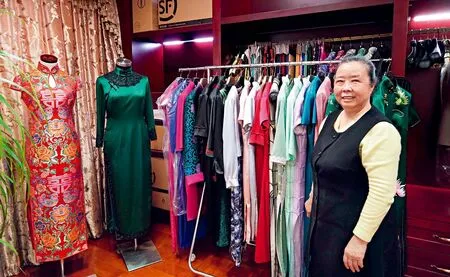In The Mood For Qipao
2022-06-23ByYinKang
By Yin Kang
From traditional costume to runway gold
In a simple and traditional building in Beijing’s Dongcheng District, qipao master Li Kan is putting the final revisions on several dresses she has created for her clientele. In the corner of her studio, a finished product daintily dangles from a rack. “We offer both the classic Beijing-style qipao, or cheongsam, and modified ones, catering to women of all ages,” said Li.
Since the traditional Beijing version first graced magazine covers in the early 1920s, this particular style, known for its demure elegance, has gained worldwide fame. In 2007, it was added to the list of Beijing municipal intangible cultural heritage; Li is a fourth-generation inheritor.
Li doesn’t watch movies often, but she has frequently indulged in Wong Kar-wai’s 2000 masterpiece In the Mood for Love. She appreciates the female grace this movie delivers through heavy qipao presence.
“This dress is one of China’s most traditional apparels and an integral part of the nation’s culture,” said Li. “Despite the inflow of global clothing brands and the younger taste for new and modern styles, traditional clothing should never be overlooked. It represents the indelible aspects of Chinese culture and should not be confined to movies or museums.”
Apprentice to Master
In 1978, 21-year-old Li was assigned to work at what was then Beijing People’s Clothing Factory (today’s Hong Du Group) as a needlework apprentice. She still works in the same factory today. Her expertise on the basics of clothes-making and eye for detail made her stand out during a routine technique assessment, and she was soon promoted. She left the production workshop in 1992 to become an apprentice of qipao master Yang Huaizhi, formally becoming an artist devoted to the garb.
The dress looks very simple in terms of its cut, but construction techniques are difficult to learn. For instance, there are more than 100 ways just to hand-tie buttons.

A typical example of a knotted button. (VCG)
According to Li, a custommade qipao is specifically designed for a specific individual based on 36 points measured from top to bottom including the collarbones and elbows. After measuring and cutting, the wearer must try on the piece several times to test whether it is too loose or too tight, too long or too short. A handmade qipao requires at least half a month to craft.
Because the qipao requires more time and energy than an off-the-rack dress, the garment once fell out of public favor for quite some time. However, thanks to rising incomes and a growing interest in traditional craftsmanship over the past 15 years, Li’s Beijing-style qipao again became all the rage, with orders rolling in. In 2009, she won the title of master of Chinese traditional art skills awarded by the Beijing municipal authorities. She has also created qipaos for wives of dignitaries, both local and international, as well as celebrities. “My passion for the qipao has sustained me all along,” said Li on her past four decades. “I truly enjoy the process of meticulously designing and cutting, and, of course, my customers liking their finished products.”

Various knotted buttons. (YIN KANG)
Innovating Inheritance
Although she is maintaining a traditional technique, Li is by no means conservative in her quest for innovation and usage of new textiles and techniques. She no longer swears by the linear cutting method typically used for traditional dress patterns, but absorbs new methods prevailing in the current fashion field. Cotton prints resulted in a straightforward qipao fit for daily wear. Those made of silk and brocade are saved for more formal occasions. A qipao crafted with dark-colored cashmere or velvet not only highlights a woman’s figure and elegance, but also helps keep her warm.

Li Kan and her works of qipao art. (YIN KANG)
Li also took her pioneering knack to the knotted buttons by introducing flowers into their elaborate styles as well as glimpses of traditional Chinese painting. “Nowadays, we’re starting to see a growing number of young customers,” Li said. “Some choose to wear a qipao for important occasions like a wedding ceremony, so we need to learn more about the younger ideas and demands by better communicating with them.”
Crafting the Next Generation
Li hopes not just to sell to more young clients, but also to see more youngsters inherit qipao-making skills.
“Recent years have seen many masters retire from the craft,” she said. “As this team of traditional qipao makers shrinks, we, as a country, run the risk of losing the technique for good. Some tailors felt the work was tedious and underpaid and turned to other brands to do design or marketing. Others quit the clothing sector altogether.” The good news is that in recent years, the country has done much to promote national craftsmanship, which has brought various traditional techniques back into the limelight.
A growing number of fresh faces have been joining the lineup to resuscitate these practices. “It’s great to see them commit to Chinese cultural heritage,” she explained.
Li has been taking on apprentices since 2008. She works out training schedules based on their individual capabilities and market demand. “I have been working on qipaos for almost my entire career, and it is my mission to pass this technique on to the next generation,” Li proclaimed.
